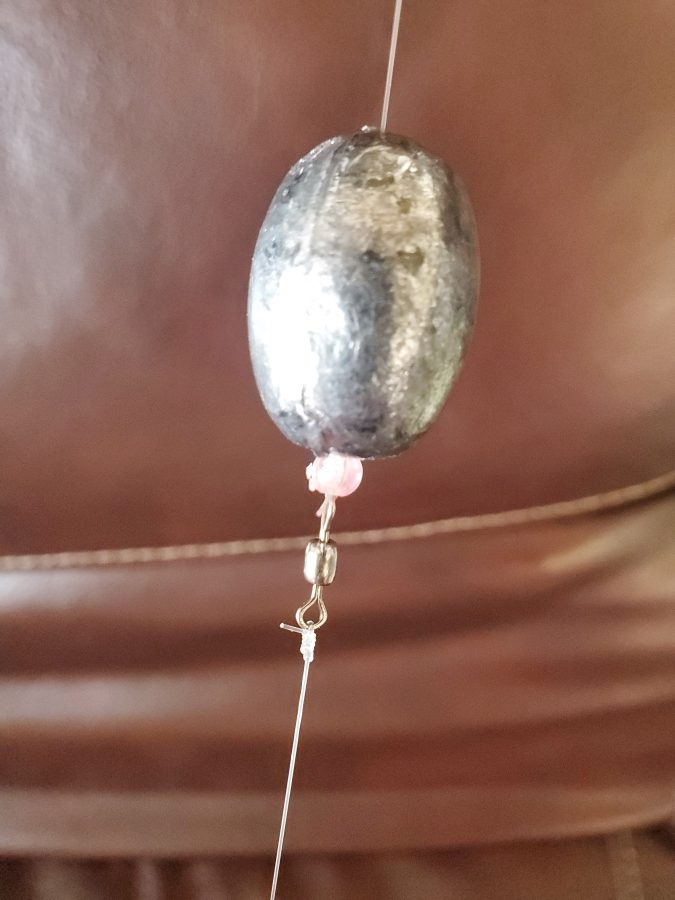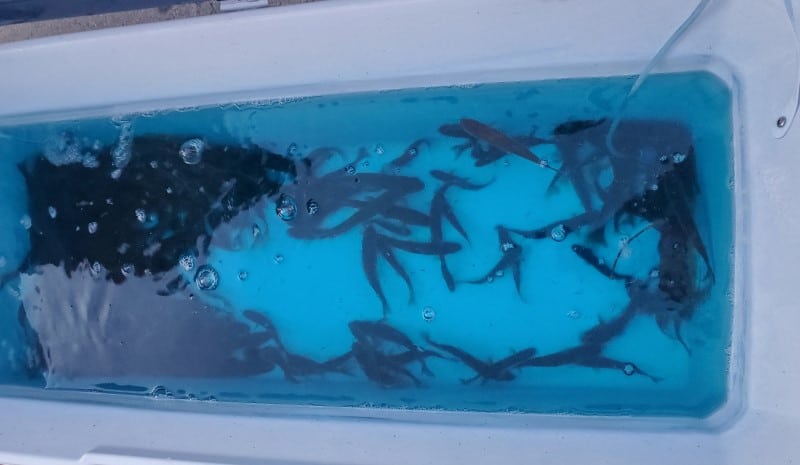This is a continuation article series on how to properly fish creek chubs and rig them properly. You can read about how to trap & fish creek chubs here.
Creek chubs, as I’ve talked about many times on both articles and our podcast, are great big-fish baits. They’re usually big and feisty, and for various reasons fish just love them.
The common misconception of fishing creek chubs is to think that just because you have them on the line, fish are just going to swarm to them. That’s just not the case.
The key is to be ON the fish, THEN the bait matters. But at the end of the day, that’s the case with all fishing, isn’t it?
So with that being said, you can really fish chubs any way you fish minnows. Some people pitch jigs with them, others even use them behind bottom bouncers.
But for us, we rig them in a special way. I may sound very one-dimensional, but this technique usually works (when we’re marking fish, of course).
So I will explain, in detail, exactly how we rig our creek chubs for fishing.
Tying a Creek Chub Rig
First off, you need to understand what we’re trying to accomplish. I like to rig my chubs so they can swim freely, and with very little resistance when the fish picks up the bait (assuming I open the bail on the reel at the right time, more on that later). We feed the line for often as long as a minute or two (often debated), so ensure the hook is in their mouth for a good hookset.
The creek chub rig, in my opinion, is about as simple as it comes. Let’s start with the hooks.
We use circle hooks, usually in size 4. Circle hooks are mostly used in catfishing circles, but these hooks work great for walleyes too (and other species). You DO NOT set the hook with circle hooks, rather, you get the line tight and simply reel (obviously keeping tension on the line). We like to hook the chub through the nostril, so it barely hurts the bait. This allow thems to swim freely.
The leader length, which is also debatable, can vary between 2 and 6 feet (typically). I like to keep my chubs on a short leash, so we usually run 2 to 3 feet for our leaders. Otherwise, longer leaders can almost allow the chub to swim TOO MUCH. Again, this is my take…I’ve heard others.
We use monofilament for making our creek chub leaders. Why? Well, it floats, that’s why. Fluorocarbon sinks, and the fewer snags the better. I usually use 10-lb. Test Fireline for my mainline, and 8 or 10 lb. test for my leader line (I use Berkley Trilene XT).

I then tie my leader to a VERY SMALL ball-bearing swivel. The larger it is, the more resistance the fish can potentially pick up while taking the bait. So with that being said, I like to keep my swivels small for this application.
From there, I run a bead (mostly to protect the knot from abrasion) and a ¾ oz. sliding egg weight. I’ve used heavier weights, but for up to 40 feet of water, the ¾ oz. has fared well in most conditions.
Below is a video that shows how we tie the leader. We usually DO NOT use a stinger hook, but rather, just 1 circle hook. I’ve had better luck without stinger hooks. With that being said, just ignore the part about the 2nd hook. 🙂
Fishing with Creek Chubs
So now you have the rod/reel all rigged for chubs, now it’s time to start thinking about fishing with creek chubs.
Here in North Dakota where I reside, you can use 2-lines at a time. So I normally either fish 2 creek chub rods or 1 creek chub rod as a deadstick and fish jigging raps with the other.
More often than not, I’m fishing the latter of the 2. I think with a choice bait and a jigging rap, you can catch a fish in any mood. One is a reaction, the other is force-feeding. Either way, this is what works well for us.
What sucks about fishing with creek chubs, is we normally fish them slowly. With that being said, this isn’t the best presentation if you need to cover a BIG flat (for example). We usually go .2 to .5 mph when rigging creek chubs. Not the best for covering ground…
So think of rigging creek chubs for spot-on-the-spot fishing. Points, humps, breaks, etc. are where we usually target to fish chubs.
We like to sit on our fish and work them until they bite. Again, normally we aren’t fishing giant areas, but smaller structures. So normally it doesn’t take long to cover.
More often than not, when a fish approaches your chub on the end of your line, it’ll start freaking out. If you have a sensitive rod tip, you can see it. Now some say you should open the bail NOW, but I usually hold onto the rod and release the bail as soon as I feel any tension.
From there, just give it some time. If the fish SLAMMED the creek chub and bent over the rod, don’t feed it. Just keep it tight and reel, especially with circle hooks.
If it was a light bite, we normally feed the line for a minute or more. Just depends on the day.
When you reel up the slack, do it slowly, until you feel tension. From there, I just raise the rod tip to tighten and reel, slowly, until it’s in.
I can’t stress enough that when fishing circle hooks, you should keep the line super tight at all times.

Recap
As I said in the beginning, there are a ton of ways to fish creek chubs (or minnows, for that matter). This method of rigging creek chubs just works for us.
We normally use the 30-quart Engel Cooler for keeping our chubs in the boat. We usually don’t add more than 30-40 chubs, however (depending on the size). And it’s a good idea to use a frozen water bottle to add to the water to keep it cool. And ALWAYS aerate your creek chubs, at all times.
On good days, you can go through 30-40 chubs pretty quick so sometimes we’ll bring a 2nd container (especially during tournaments).
It’s often used for catching BIG fish. You know the old saying…big baits equal big fish. And that’s what we’re after when fishing creek chubs.
Tight Lines My Friends…
